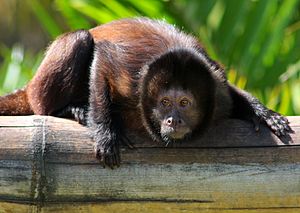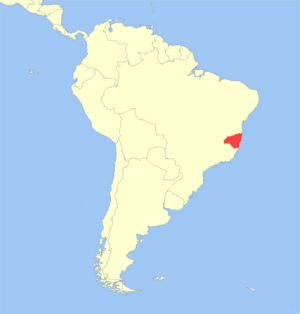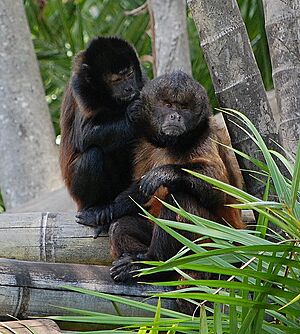Crested capuchin facts for kids
Quick facts for kids Crested capuchin |
|
|---|---|
 |
|
| Perched on a platform | |
| Conservation status | |
| Scientific classification | |
| Genus: |
Sapajus
|
| Species: |
robustus
|
 |
|
| Crested capuchin range | |
| Synonyms | |
|
|
The crested capuchin (Sapajus robustus) is a special type of monkey. It is also known as the robust tufted capuchin. These monkeys live only in Brazil. For a long time, scientists thought it was just a kind of black capuchin. But now, many experts believe it is its own unique species.
Contents
About the Crested Capuchin
How Scientists Classify Them
When the crested capuchin was first found, scientists gave it the name Cebus apella robustus. They thought it was a subspecies of the tufted capuchin. Later, in 2001, another scientist suggested it was a subspecies of the black capuchin.
In 2012, scientists looked closer at these monkeys. They suggested that all "robust" capuchins should be in a new group called Sapajus. They also found strong evidence that the crested capuchin is a separate species. This means its new scientific name is Sapajus robustus.
Scientists even studied the monkey's mitochondrial DNA. This research showed that the crested capuchin separated from the black capuchin over 5 million years ago. This discovery helped confirm that it is a distinct species.
What They Look Like
The crested capuchin has a very unique look. Unlike other capuchin monkeys, it has a cone-shaped crest on top of its head. This crest is bright red with a black spot. Sometimes, this cone shape continues around the sides of its head, making it look like it has a black beard.
The rest of its fur can be brownish-red or yellowish-brown. Its forearms, lower legs, and tail are usually black. However, some females might have a mix of black and light yellow fur in these areas. Females also have two small tufts of fur on their head that males do not have.
Crested capuchins are medium-sized monkeys. Their head and body together measure about 33–57 centimetres (13–22 in) long. Their tail is also quite long, about 40–47 centimetres (16–19 in). Male crested capuchins are usually bigger than females. They can weigh between 2.0–3.8 kilograms (4.4–8.4 lb).
Where They Live
Crested capuchins used to live in a larger area of Brazil. This included parts of Espírito Santo, Minas Gerais, and Bahia. They lived along the Atlantic coast.
However, their home has become much smaller. This is because their forest homes are being destroyed. Now, they are mostly found in eastern Minas Gerais and parts of Bahia. They prefer to live in the middle and lower parts of tropical lowland forests. They can also be found in drier forests in the western part of their range.
How They Live
What They Eat
Crested capuchins eat many different things. Their diet includes fruits, seeds, and insects. They also eat frogs and even small mammals. They are very good at using their hands to get food. They can skillfully open items to reach the food inside.
Do They Use Tools?
While no one has seen crested capuchins using tools yet, it is very possible they do. Other types of robust capuchins, like the black capuchin, are known to use stones. They use these stones to crack open hard-shelled fruits or even oysters. Since crested capuchins are similar to these monkeys and live in similar areas, they might also use tools in the same way.
Their Social Life
Scientists haven't studied the social life of crested capuchins in detail. But they likely live in groups with a clear pecking order, similar to other capuchin species. There is usually a top-ranking male who is in charge, even over the top-ranking female. Other males might be part of the group but often stay on the edges.
Protecting the Crested Capuchin
Why They Are Endangered
The crested capuchin is an endangered species. The IUCN first listed them as vulnerable in 1995. By 2008, their situation worsened, and they were classified as endangered.
Even though some of their homes are in protected areas, they only live in a small region. They face two main threats:
- Hunting: People hunt these monkeys.
- Habitat Loss: Their forest homes are being cut down. This land is often cleared for farming.
These threats put a lot of pressure on the crested capuchin population. Efforts are needed to protect their remaining habitats and ensure their survival.



